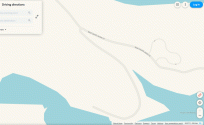I've been wondering, and I'm sure others have as well, why Kiely didn't just use her iPhone to navigate out of the area. Apple Maps doesn't have the detail of Google Maps when it comes to dirt roads and trails, and/or does not update as frequently. Taking a look at a screenshot of the campground from Apple Maps,
View attachment 374256
we see that at 1 inch = 375 feet, only the main road from the campground is visible. But if we zoom in to 1:125, other roads appear, including the road she was on until that fork in the road:
View attachment 374255
Interestingly, Apple doesn't delineate that road beyond the fork, probably because it isn't passable past there at maximum reservoir capacity.
Now Google Maps shows more "roads" at all scales:
View attachment 374257
But does this difference between apps and platforms really matter? IMO, not really. Apple Maps would provide the basic information to show her that she needed to head west to get out of the campground and back on the highway. That is, if she was using it....
I believe Kiely
wasn't using a GPS or map app because of the impaired state she was in. She may also not have trusted Apple to show the road(s) she was on. Additionally, she was probably task-saturated, absorbed with texting mom (and others), as well as using her eyes to see through the darkness and (possibly) mist/fog on and close to the water, in order to get home at a time when she shouldn't have been on the road at all at her age. I doubt she was directionally dyslexic by nature, because I know some people who are, and they absolutely depend on GPS at all times to get them where they are driving. But her state of mind may have made her so.
Speaking of fog, a check of the 2013 CR-V LX specs (the manual is no help here), and of KR's VIN, shows that
the LX trim level, even with AWD, does not include fog lamps; they were only available on the EX and EX-L (aftermarket upgrading of this kind is never worth it--BTW I couldn't find a decent head-on view of her car). This means that Kiely was probably not able to see as well as she could have with comparable vehicles, including the legendary Subaru Outback. If there was fog over the lake, it could've hidden the water until the last second. Remember that would be impossible to see fog on the lake from the fire cam because 1) IR cameras, by definition, see through fog and smoke, and 2) the pitch-black night footage has been overlain with daylight imagery for viewing convenience.
We have "driven" these roads much earlier in the general thread. But this was long before the firecam footage, which showed her pausing at the intersection before making that fateful turn. When she came to the fork in the road, Kiely should not have taken it at all--she should have turned around and gone back the way she came when she left her parking space. If she had been using her iPhone to navigate, it would have told her this, and gotten her out of the area.
MOO








